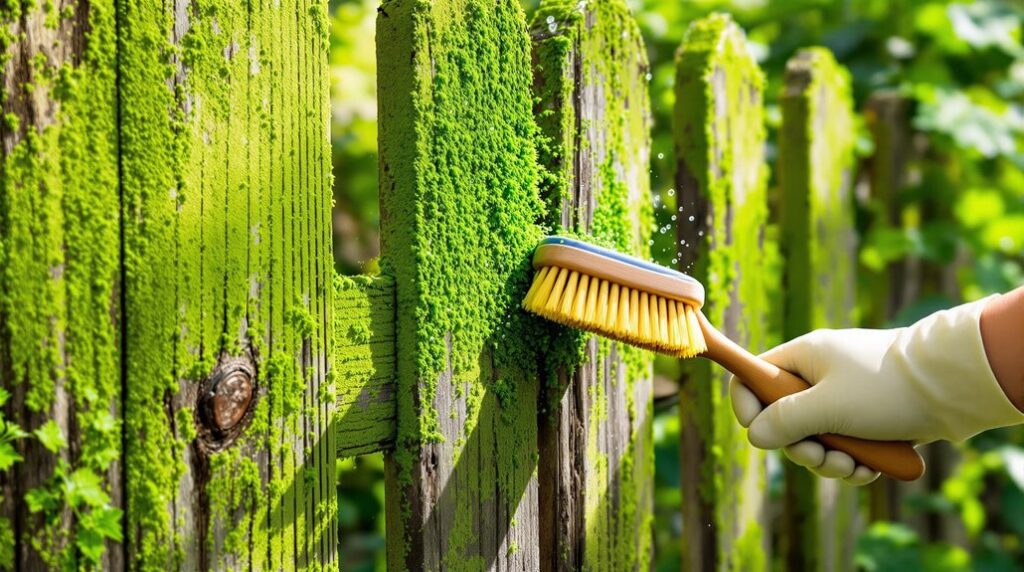I’ve dealt with plenty of algae-covered fences over the years, and I can tell you it’s one of those problems that sneaks up on you. One day your fence looks fine, the next it’s sporting that telltale green film that makes your entire yard look neglected. The good news is that removing algae doesn’t require expensive equipment or harsh chemicals – but there’s definitely a right way and wrong way to tackle this issue without damaging your fence.
Key Takeaways
- Clear debris and trim overhanging vegetation to increase sunlight exposure and airflow around the fence surface.
- Use white vinegar mixed with equal parts water, letting it sit 15-30 minutes before scrubbing stubborn algae spots.
- Apply commercial fungicidal concentrates for wooden fences, allowing 2-hour dwell time before thorough rinsing with garden hose.
- Rinse completely after treatment and allow natural air drying in sunlight to prevent cleaning solution residue damage.
- Install copper wire along fence tops and apply waterproof sealant annually to create long-term algae prevention barriers.
Understanding What Causes Algae Growth on Wooden Fences
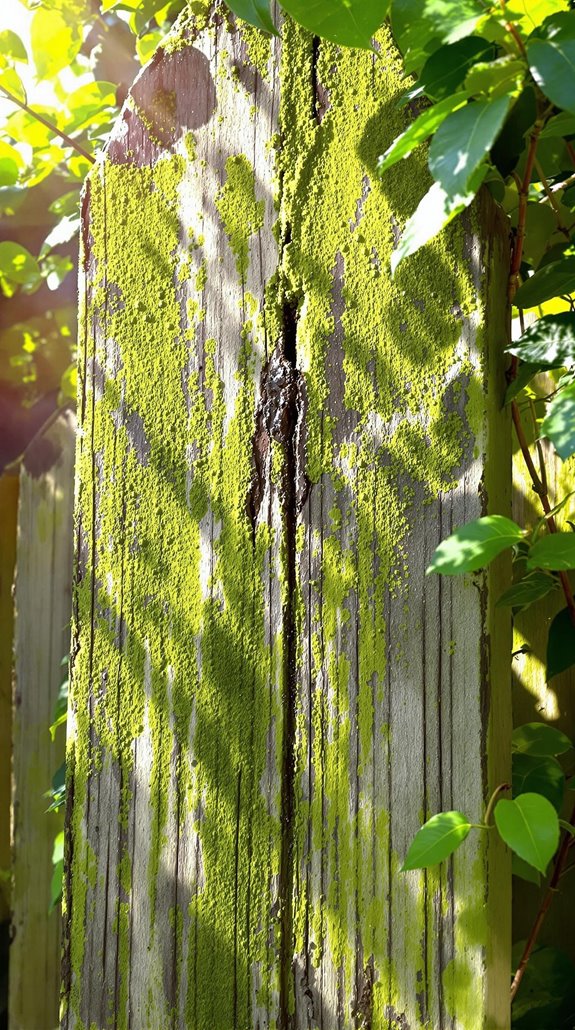
When algae takes hold of your wooden fence, it’s typically the result of a perfect storm of environmental conditions working together. I’ve found that moisture is the primary culprit – whether from frequent rainfall, high humidity, or poor drainage around your fence base. Your fence becomes especially vulnerable when it’s constantly shaded by overhanging trees or dense vegetation, preventing proper drying and UV exposure that would naturally inhibit algae growth.
The wood itself contributes to the problem. Its porous nature traps moisture while providing organic nutrients that algae loves. Add accumulated dust, pollen, and organic debris settling on surfaces, and you’ve created an ideal breeding ground. What many homeowners don’t realize is that algae spores are already present everywhere in the environment, simply waiting for the right conditions to activate and multiply. Warm temperatures and stagnant air around your fence accelerate this process, turning your once-pristine barrier into a green, slippery mess that needs immediate attention.
Essential Preparation Steps Before Starting the Cleaning Process
The success of your algae removal project hinges on thorough preparation that sets you up for effective cleaning. I’ll walk you through the essential steps that make all the difference.
First, I clear away debris like leaves and dirt from the fence surface. Next, I prune any overhanging plants to reduce shade and improve airflow around the fence – this prevents future algae growth.
For surface dirt removal, I assess the situation. If there’s heavy dirt buildup, I use a pressure washer followed by adequate drying time. For lighter dirt, I brush with hot soapy water instead.
I also gather my essential cleaning tools including a bucket of warm water, a scrub brush with medium bristles, and a garden hose with spray nozzle. Having the right cleaning tools ready ensures a smooth and efficient algae removal process.
These preparation steps guarantee your cleaning efforts will be more effective and long-lasting. Proper prep work saves time and delivers better results.
Natural and Eco-Friendly Cleaning Solutions for Algae Removal
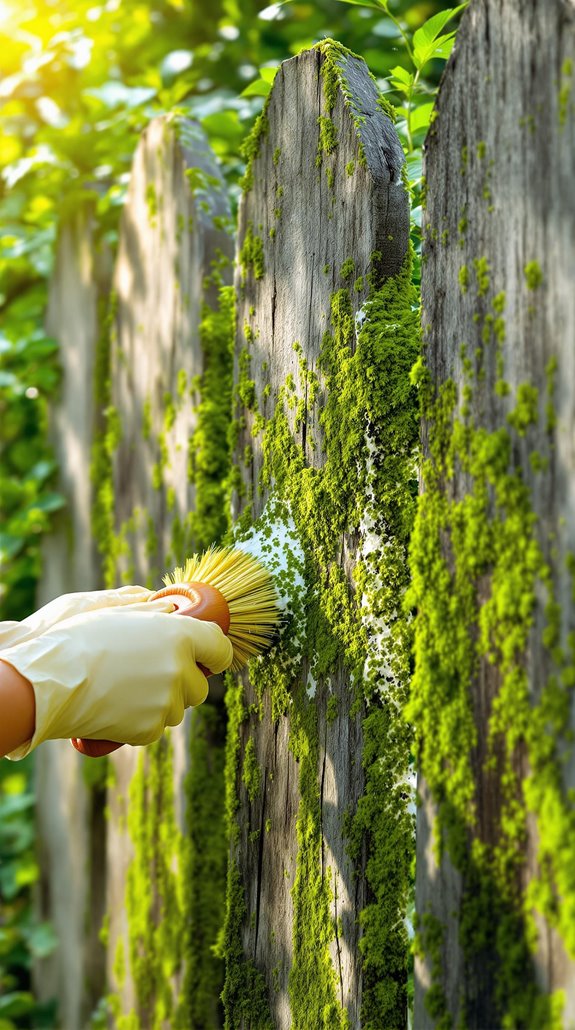
Natural cleaning solutions offer powerful algae-fighting capabilities without harming your fence or surrounding environment. I’ll share three proven methods that fellow gardeners swear by.
White vinegar mixed with equal parts water creates an effective spray that breaks down algae naturally. Let it sit for 15-30 minutes before scrubbing. For stubborn spots, I make a baking soda paste with minimal water—its gentle abrasive action lifts algae without scratching wood grain.
Hydrogen peroxide works as my go-to oxidizing agent for persistent stains. Apply it undiluted and wait 10-15 minutes before scrubbing with soft-bristled brushes using circular motions.
Always rinse thoroughly after each treatment. These eco-friendly solutions protect your plants while delivering the clean fence you’re after. Regular maintenance with these natural cleaners prevents the build-up of dirt and organic matter that creates ideal conditions for future algae growth.
Commercial Products That Effectively Target Stubborn Algae
Sometimes natural solutions won’t budge the most stubborn algae growth, and that’s when commercial products become your best ally. I’ve found sodium hypochlorite-based cleaners incredibly effective for vinyl and concrete fences—they’ll dissolve algae in under 30 seconds without scrubbing. For wooden fences, I prefer fungicidal concentrates that eliminate algae at the cellular level while preserving wood integrity. You’ll need to allow a 2-hour dwell time before rinsing. Additionally, using these cleaners can help enhance your home’s energy performance, as a well-maintained fence contributes to overall property value.
After cleaning, I always apply protective wood sealants like Emperor Exterior Wood Waterproofer. It creates a moisture-repellent barrier that prevents regrowth and extends your fence’s lifespan. This waterproofing treatment can last up to 25 years, making it a worthwhile long-term investment for your fence protection. Remember to pre-wet surfaces before application and rinse thoroughly afterward. These commercial solutions tackle what natural methods can’t, giving you professional-grade results every time.
Proper Techniques for Applying and Scrubbing Cleaning Solutions
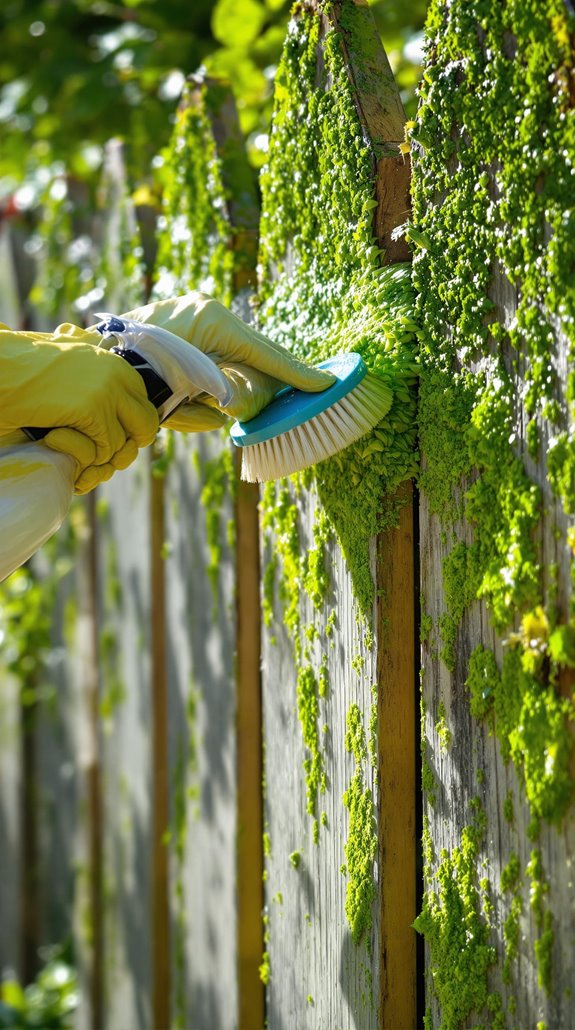
Master the application process and you’ll transform stubborn algae removal from a frustrating chore into a systematic success. I always use a pump sprayer for even coverage, saturating algae-heavy areas thoroughly while spraying downward to minimize waste. For stubborn spots, I apply solution directly with a brush for targeted treatment.
When scrubbing, I use medium-bristle brushes and follow the wood grain direction to preserve the fence’s integrity. I apply moderate pressure on textured areas where algae persists, using circular motions on thick patches. Wire brushes are off-limits—they’ll scar your wood surfaces.
Timing matters too. I allow vinegar solutions 5-10 minutes before scrubbing, while specialized removers work overnight. I reapply to drying areas and avoid letting solutions dry completely on wood. Always remember that regular cleaning helps maintain fence integrity and prevents costly repairs down the line.
Rinsing and Drying Methods for Optimal Results
Once you’ve scrubbed away the algae, thorough rinsing becomes your next priority to prevent cleaning solution residue from damaging your fence. I’ll use my garden hose to rinse every section completely, guaranteeing no vinegar solution remains on the wood surface. Clean water works best for this final rinse step.
After rinsing, I’ll allow the fence to air dry naturally. Sunlight helps speed up the drying process, but I’ll give it adequate time regardless of weather conditions. The wood needs to be completely dry before I apply any protective treatments or stains. I’ll maintain at least 2 feet distance from the surface when using a pressure washer to avoid damaging the wood.
I’ll inspect each panel during the drying phase, checking for any missed algae spots or residue streaks. This thorough approach guarantees my fence is properly cleaned and ready for the next maintenance step.
Prevention Strategies to Stop Algae From Returning
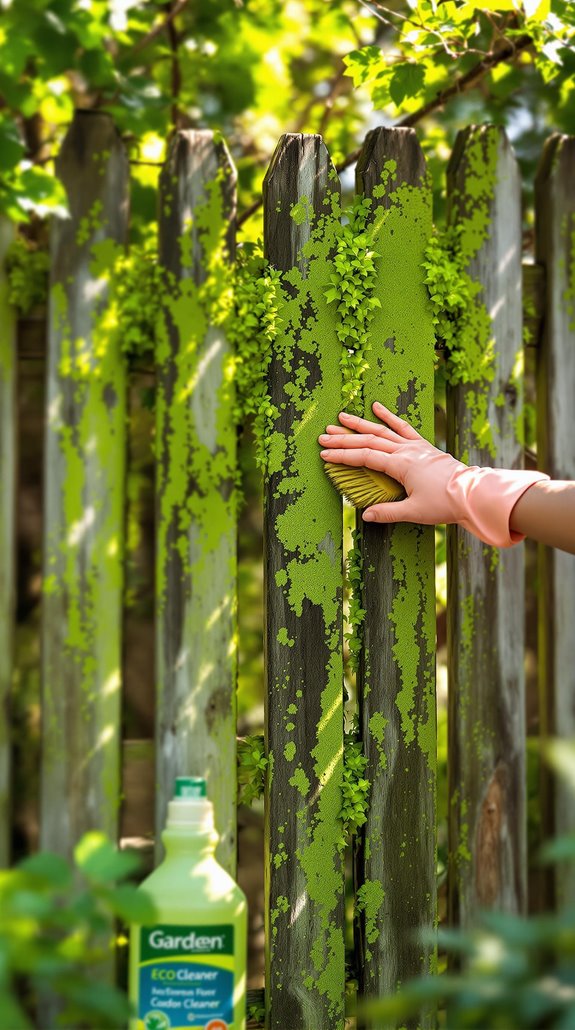
After successfully removing algae from your fence, implementing targeted prevention strategies will save you from repeating this labor-intensive process. I’ll focus on waterproofing since moisture creates the perfect breeding ground for algae growth.
Apply waterproof sealant annually to create an effective moisture barrier on your wood surfaces. Clear debris like leaves and dirt regularly—they trap water and feed algae. Make certain proper drainage around fence bases by installing gravel or adjusting soil grading to prevent standing water.
Trim overhanging vegetation to increase sunlight exposure and airflow, which naturally discourage algae. Consider installing copper wire along fence tops—it releases algae-inhibiting ions when wet. Finally, wash your fence every few months with plain water to remove organic buildup before algae establishes itself.
Regular inspection of your fence allows you to catch algae formation early, preventing the slimy film from fully developing across wooden surfaces.
Long-Term Maintenance Schedule for Fence Protection
Building on these prevention methods, I’ll outline an extensive maintenance schedule that keeps your fence protected year-round. I recommend annual inspections for rot, cracks, and warping, especially near the base where moisture accumulates. You’ll want to apply water-repellent stain or sealant every 2-3 years using a brush, roller, or pump-sprayer at the recommended coverage rate.
To maintain good relations with your neighbours, it’s important to be aware of your property rights regarding boundary issues, which can influence your maintenance decisions. For cleaning frequency, I suggest washing vinyl fences every four months, wood fences annually with mild detergent, and metal fences monthly with soap and water. During wet seasons, increase your cleaning frequency since algae thrives in moisture. After harsh weather events, inspect more frequently and repair damaged sections promptly. Additionally, trim back surrounding vegetation to reduce moisture retention around your fence perimeter. This systematic approach guarantees your fence remains algae-free and structurally sound for years to come.
Conclusion
I’ve walked you through every step to eliminate algae and restore your fence’s appearance. You’ve got the tools and techniques—from natural solutions to commercial products—to tackle any algae problem. Don’t skip the prevention strategies I’ve outlined; they’ll save you time and effort down the road. Stick to the maintenance schedule, and you’ll keep your fence looking great year-round. Your garden’s beauty depends on consistent care, so make this cleaning routine a priority.
References
- https://www.freedomfencefl.com/how-to-remove-algae-from-a-wooden-fence
- https://www.eastcoastfencing.com/news/how-to-remove-green-algae-from-wooden-fences
- https://gkproductsuk.com/blogs/news/how-to-get-rid-of-green-algae-on-fences
- https://www.wetandforget.com/blog/2023/02/14/how-to-clean-a-fence/
- https://www.knowoodworks.com/about-us/blog/artmid/531/articleid/3/how-to-remove-green-algae-from-your-wood-fence
- https://emperorpaint.co.uk/blog/how-to-remove-algae-from-fences-permanently/
- https://www.homesandgardens.com/gardens/how-to-remove-algae-from-a-fence
- https://www.perimtec.com/why-a-wood-fence-turns-green/
- https://www.idealhome.co.uk/garden/garden-advice/how-to-remove-algae-from-a-fence
- https://www.inyourarea.co.uk/news/how-to-remove-fence-algae-with-effective-homemade-solution

